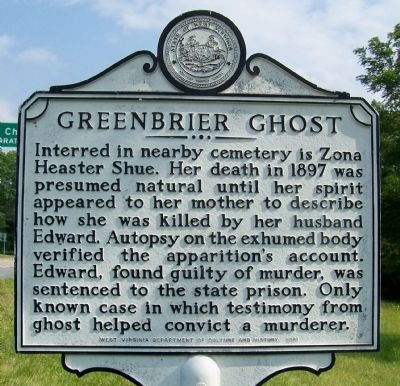It’s October and time for ghost stories. Some of these are well known, some well-known but the details often glossed over, and some are not known to those beyond their small towns.
Today we’re starting with the story of the Greenbrier Ghost. In November 1896, Erasmus Shue married Zona Heaster, making her his third wife. He was a drifter and had spent time in prison, but after marrying Zona settled down in Greenbrier County where he took work as a blacksmith. As all blacksmiths, Shue was extremely strong. Only two months later, in January 1897, Zona was found dead by the young son of a neighbor.

Shue’s coworkers said he had been acting strangely that morning and was unable to concentrate on his work. He had repeatedly requested the neighbor boy go to his house to do chores. When the boy was finally able to make it up there around lunchtime, the boy came back reporting that Zona was dead. She was “found in the dining room, lying stretched out and her clothes pulled down, and apparently had been dead for some hours.” The doctor determined her death to be due to heart failure, for which he had been treating her the preceding weeks. Her body was taken to her father’s house. Shue was strangely protective of the body, refusing to let anyone view it out of his presence. He also insisted upon placing a folded sheet by her head and would not let anyone remove it. His behavior at work had been noticed as well, and soon the members of the community were voicing suspicions that Zona’s death was not, in fact, natural.
Zona’s mother then came forward, stating that she had prayed for the truth of Zona’s death to be revealed to her. As an answer to her prayers, Zona’s ghost had visited her for four nights. Zona told her mother that Shue had murdered her because he was angry she had not prepared meat for his dinner. She described that he had squeezed her neck very hard, crushing it, and she had died as a result. She described her home and neighborhood, where her mother had not yet visited, in great detail. Mrs. Heaster’s revelation prompted a second inquest into the murder.
The second examination determined that she had, in fact, been murdered. Her neck had been broken and her windpipe crushed. Shue was arrested. It was no great leap to believe him the most likely murderer. He certainly had the strength to snap his wife’s neck with his bare hands, and his behavior at the wake and funeral had aroused no small amount of suspicion. He was also a convicted criminal. At the trial, Zona’s mother was brought to testify. Under oath, she repeated her story of Zona’s visitation, stating that she knew that Zona had been sent to her by the Lord to ease her heart. As 1897 was a much more religious time than now, her testimony was not immediately discounted. Furthermore, Mrs. Heaster stated that she had taken the strange sheet from Zona’s coffin home. Upon getting home and washing it, she noticed a large red stain. The sheet was also admitted to the court as evidence.

After eight days, the jury found Erasmus Shue guilty of murder. However, they recommended mercy to him and so instead of dying by hanging he was sentenced to life in prison. He died at some point in the West Virginia State Penitentiary in Moundsville.
Interestingly, this is not the only case of a ghost accusing a man of murder in West Virginia. In Wetzel County in May of 1854, Laban Mercer was put on trial for the murder of John Gamble. Gamble had been found deceased and floating in the Ohio River in 1850. In the fall of 1853, a “respected citizen” of Wetzel County placed an affidavit before a local magistrate that a ghost had visited him in the woods and informed him that Laban had killed Gamble. The Court ruled the “testimony” of the ghost inadmissible and Mercer was set free.

For this entry, I drew chiefly from historical newspaper research. Shirley Donnelly’s column in the Beckley Post-Herald was extremely helpful. The West Virginia State Archives also has a collection of clippings (text only) related to the trial, which can be found here.
